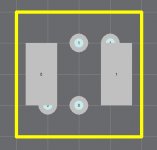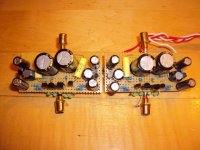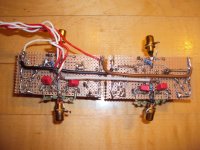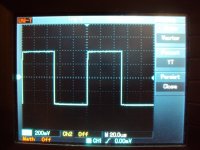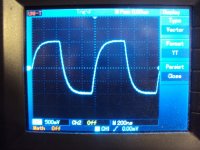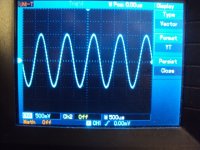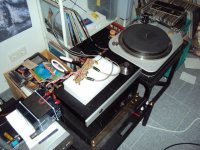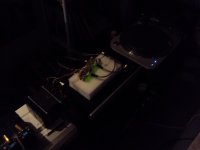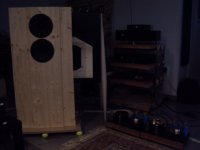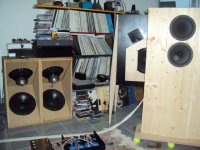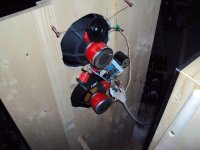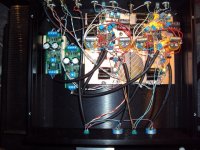the caps are so big, that even in the schematic I had to introduce a wire that is not horizontal or vertical, but inclined.... understand now why Piet Mondrian felt so strongly about this.... ;-)
3921 is definitely art. It has a purpose and looks interesting. I never heard about an inclined wire though.
I was curious how good the Sanyo transistors are so i build a little pre-pre that uses a simplified version of the Paradise input stage. I will listen to it tomorrow because the family is in bed. I measured it though.
The circuit has very good speed. With a gain of 23x i got a -3dB point of 4.3Mhz with a little underdamped overshot. So G/BW is nearly 100MHz. I build in a 6dB filter to limit the response to 1.7MHz. The screen shots are with this filter. The 10kHz square is just a square. CD players can only dream about this performance. That does not say that vinyl per se has no problems with extended range but this Pre-Pre will not limit the input signal. The 100kHz square is nicely rounded after modification and the 1MHz square shows the slew rate with 10V per usec. That is very fast for a low level input stage.
The sine wave shows the response to a 87mV signal, my limit because i use a voltage divider. Theoretically it can throw 12V P-P so this is not the limit of performance. This stage is hard to override. Even an MM can not overdrive it and this is with only 6V over the cascodes. The Paradise is 6dB better because we use 12V. I tried to measure noise but the resolution of my scope is too poor. With a low noise circuit like that i always get around 0.5mV, no matter what it performs in reality. There are some high frequency spikes and hum but this is naked on my bench.
The listening will reveal how the noise spectrum sounds.
The circuit has very good speed. With a gain of 23x i got a -3dB point of 4.3Mhz with a little underdamped overshot. So G/BW is nearly 100MHz. I build in a 6dB filter to limit the response to 1.7MHz. The screen shots are with this filter. The 10kHz square is just a square. CD players can only dream about this performance. That does not say that vinyl per se has no problems with extended range but this Pre-Pre will not limit the input signal. The 100kHz square is nicely rounded after modification and the 1MHz square shows the slew rate with 10V per usec. That is very fast for a low level input stage.
The sine wave shows the response to a 87mV signal, my limit because i use a voltage divider. Theoretically it can throw 12V P-P so this is not the limit of performance. This stage is hard to override. Even an MM can not overdrive it and this is with only 6V over the cascodes. The Paradise is 6dB better because we use 12V. I tried to measure noise but the resolution of my scope is too poor. With a low noise circuit like that i always get around 0.5mV, no matter what it performs in reality. There are some high frequency spikes and hum but this is naked on my bench.
The listening will reveal how the noise spectrum sounds.
Attachments
I sleep unusual hours, but you are right.
I will put the pre-pre dude now in my system and listen a bit to music.
I will put the pre-pre dude now in my system and listen a bit to music.
The pre-pre is now in the system. As MM stage i use the JGSelf precision RIIA.
The good news is that the circuit is very quiet. At very high levels on my 98dB sensitive speakers it is hard to distinguish from the back round noise. Fully cranked, ear at speakers the noise sounds very soft and even. No flicker noise, no popcorn noise, very low 1/F break point ( low noise in the bass ) so this Sanyos are very good.
The sound i get is very transparent and has high speed. For something so simple i am surprised. It looked good on the scope though. So this is a proof of concept of the Paradise input stage.
See some pictures of my current system.
The good news is that the circuit is very quiet. At very high levels on my 98dB sensitive speakers it is hard to distinguish from the back round noise. Fully cranked, ear at speakers the noise sounds very soft and even. No flicker noise, no popcorn noise, very low 1/F break point ( low noise in the bass ) so this Sanyos are very good.
The sound i get is very transparent and has high speed. For something so simple i am surprised. It looked good on the scope though. So this is a proof of concept of the Paradise input stage.
See some pictures of my current system.
Attachments
Dough Self precision RIAA preamp is an ordinary, app. notes level design. It is very strange when author of a huge numbers of exotic circuits promote such a simple op-amp based circuit. I built it a few years ago and got mediocre results with Shure VST-V cartridge. When I replaced it with Borbely phono preamp, difference was night and day. If Precision RIAA is such a good preamp, for experienced builders of course, why wasting time with discrete circuits, making complicated PCB etc. It is like chief Fiat designer drives Citroen car.
I use only his equations and only the MM section. My circuit is DC coupled and uses OPA1641 opamps plus much better passive parts and PSU. The many un bespoke electrolytics in his design are really dread full.
I agree, the Self Precision RIAA they way he presents it in his books sounds mediocre, the math is precise though.
I use that circuit as a benchmark only.
I agree with you. A well designed discrete circuit sounds better.
I did not want to give the impression that this is state of the art but i have heard much worse.
I agree, the Self Precision RIAA they way he presents it in his books sounds mediocre, the math is precise though.
I use that circuit as a benchmark only.
I agree with you. A well designed discrete circuit sounds better.
I did not want to give the impression that this is state of the art but i have heard much worse.
routing is finished... now adding the ground planes and component values, and making it look nice....
I will make some photos and i assume they do too.
I got a haircut from Gudrun today. I look like a chicken.
No, this visit was planed for some time. We have to talk about the karma of the universe.
I am an expert on that. After all black holes are burned out and the particles are moved far away enough from each other so that the red displacement is so high that they do not see each other any more there is chance for a quantum potential. That can lead to a new big bang.
I got a haircut from Gudrun today. I look like a chicken.
No, this visit was planed for some time. We have to talk about the karma of the universe.
I am an expert on that. After all black holes are burned out and the particles are moved far away enough from each other so that the red displacement is so high that they do not see each other any more there is chance for a quantum potential. That can lead to a new big bang.
Green boards
Hi Joachim,
What are those boards on the left (Two green boards) ?
Gr,
Audiofanatic 🙂
This is the JGSelf inside. It is quite a sophisticated beast. i gave my best to squeeze out
the best possible sound.
Hi Joachim,
What are those boards on the left (Two green boards) ?
Gr,
Audiofanatic 🙂
